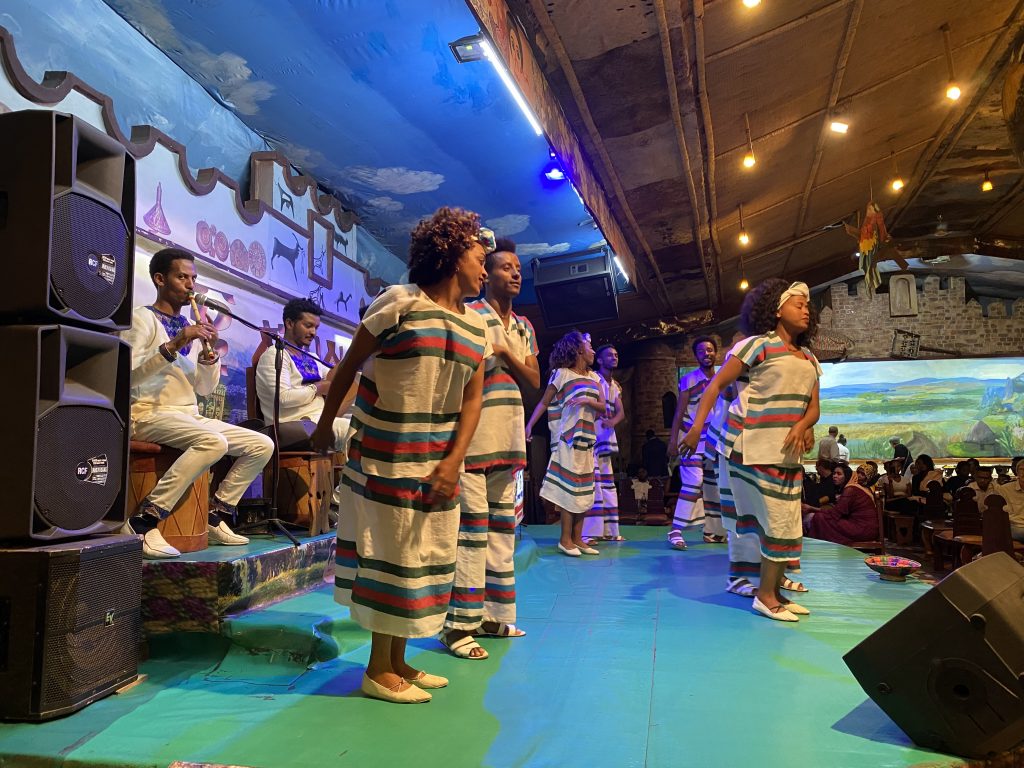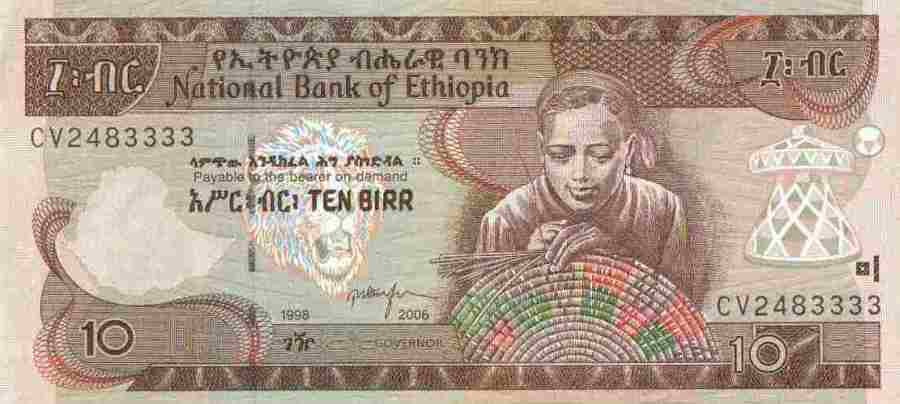Before traveling to Ethiopia, the only exposure I had to Ethiopian culture was the food. In fact, there are many Ethiopian restaurants in London. My favourite places in London are Addis, Kokeb and Dukem Butchers. Although Dukem Butchers does not have a website, it is a well-known place amongst locals and the Ethiopians in London. On one occasion, a friend invited me and her Ethiopian friends to dine there and it was a memorable experience! Of course we had the spongy injera (flatbread). In addition, we had a variety of meat stews, lentils, vegetables and raw ground beef (kitfo). I had expected to eat a lot of meat in Ethiopia, but I happened to travel during the lent period. Therefore most people were abstaining from meat, and I was able to taste a lot of their vegetarian foods. And of course injera!
Besides the cuisine, I also knew about the Unesco World Heritage sites in Lalibela, where there are magnificent churches carved into the rock. However, I had no idea what else I wanted to see nor how to travel between areas. I was lucky to find Melese, the owner of Ethio Tours by Locals, who I can highly recommend. My personal tour started and ended in Addis Ababa. In fact, I had signed up for the small group tour, but no one else was starting on the same day. So, I had my own personal tour including having Melese with me for most of the time. I’ll write more about the trip later as there are many stories to tell! For now, I am sharing the highlights and tips which could help someone else plan their future trip to Ethiopia.



Highlights
- Entoto mountain for the view of Addis Ababa
- Holy Trinity orthodox cathedral & Museum, Addis
- Ethnographic museum at the university of Addis Ababa
- Art by Negussie Taftbese
- Drive through the chaotic Addis mercato
- Blue Nile Waterfall, Bahir Dar
- Entons Monastery, Lake Tana
- Hippopotamus near the mouth of the Blue Nile
- Men paddling papyrus boats on Lake Tana
- Fasil Ghebbi (complex) and castles, Gondar
- Faselides’ baths and banyan trees- famous site for Epiphany, Gondar
- Church of Debre Birhan Selassie, Gondar
- Beautiful sunsets from the hills in Gondar and Lalibela
- All of the Bete (rock churches) in Lalibela including the most famous Saint George
- And once again I just have to say that the local guides were what made my entire trip an enjoyable, interesting and educational cultural experience
Before you go
- The official languages are Afar, Amharic (most common), Oromo, Somali, and Tigrinya
- Amase gnallo is thank you in Amharic
- Most people are religious. Be respectful and follow your guide through churches. Some areas are not allowed for women. I asked if I needed to cover my head and my guide said it was not necessary. Often you will need to remove your shoes.
- The Nobel Peace prize was won by the Prime Minister Dr Abiy Ahmed in 2019
- The skeleton of Lucy, our ancestor, is in the National Museum
- Bahir Dar is a malaria zone so take anti-malarial drugs or repellants and be aware of wet and dry seasons. I went during the dry season and there were still noticeable mosquitos
- Wifi can be slow in some places, so be prepared to be minimally connected



Transport
Airport pick-up in Addis is slightly chaotic, so know where to meet your guide upon arrival
Internal flights are short in small propeller planes so pack lightly for carry-ons. Addis to Bahir Dar, Gondar to Lalibela and Lalibela to Addis. No one seems to sit in their assigned seats so be prepared to sit anywhere there is a free seat.
African massage is free on the bumpy roads! The road from Bahir Dar to the Blue Nile waterfall was especially bumpy.
A small boat on Lake Tana is ideal to navigate to see the monasteries and also wildlife like hippos!
Long drive between Bahir Dar and Gondar.
In Lalibela, there are small cars like tuktuks. They come from India and are called bajag
Accommodation
Addis Ababa- Mado Hotel. I stayed there at the start and end of my trip. Central, safe, comfortable, friendly and helpful. Some issues with electricity and wi-fi going out.
Bahir Dar- Unison Hotel. Clean and comfortable, short stay, amazing customer service. When I was worried about mosquitos they actually installed a ceiling fixture and mosquito net for me. Restaurant with great food.
Gondar- Goha Hotel. Clean and comfortable, traditional decor. Great views from the top of the hill and space to walk around outside. Restaurant with traditional and western foods.
Lalibela- Top 12 Hotel. Great location, clean, comfortable, friendly, peaceful, traditional decor. Beautiful view of the sunset from the room and restaurant.
Currency
The official currency in Ethiopia is the Birr. In March 2020, the exchange rate was between 40-41 Birr per 1 British Pound.
I recommend to check the currency conversion just before you leave as this fluctuates






Food
Injera is served with almost every dish, even at breakfast. It is a flat bread with a spongey texture, made from fermented teff. Teff is a very small grain that is grown in Ethiopia. The taste is slightly sour and it is very filling.
During the Lent period, many people are fasting and do not eat meat. The Beyainatu was a large platter of injera topped with a variety of vegetarian dishes including lentils, split peas, cabbage, potato, carrot, greens like spinach, rice and pieces of teff in sauce. Shiro is blended spiced chickpea paste with spices.
The non-vegetarian foods are also often served with injera. I had beef tibs, lamb tibs. fried fish and fish tibs. All were well-spiced and some quite spicy.
I ate at Lucy restaurant near the National museum and although it is touristy, the outdoor setting is lovely and the food was tasty.
As much as I love it, sometimes I needed a break from injera, so I had grilled tilapia fish (which ended up being fried) in Bahir Dar, penne pasta in Gondar, and Kung pao chicken in Addis.
The origins of coffee are in Ethiopia so if you are a coffee drinker then you should try the Arabica beans. Tomoca is famous for being the oldest coffee shop in Addis
FAQs
Q: Do I need a tour guide?
A: It is not absolutely necessary but I would recommend it to enrich your experience. A lot of the local guides can share information you would not read in a guide book. They may also have helpful local connections, as with my guide in Lalibela who also worked for the church. He not only got us into the places before the crowds but also knew the clergy. Sometime the clergy would come out to show me the church treasures and even pose for a photo.
Q: Do people speak English?
A: The tour guides spoke English, and other languages. Most people in Addis Ababa also spoke English. However in the smaller towns, I did not find many people who spoke English so it was helpful to have local guides.
Q: Can I travel solo?
A: Yes I did it and it was a great experience with my guides! I could ask the guides as many questions as I wanted to and really got to know them over the few days. In Addis Ababa, I walked around a little bit by myself on the streets to restaurants and shops. However, I did attract attention and many men tried to talk to me and “help” me.
Q: Can I get a local sim card easily?
A: Yes there were shops for this around in Addis. I was lucky that my guide helped me to get one so I didn’t need to do it myself. I think it would be possible though!
Q: Do I need local currency (Birr) upon arrival?
A: Yes if you plan to take a taxi. If you have a guide and they are picking you up then you can take cash out in the city. However be aware that not all machines have money available. We had to try a few before we found one that was working.
Q: How easy is it to send postcards from Ethiopia?
A: Postcards were not always easy to find or they had pictures of not so recognisable places in Ethiopia. Stamps were easy to find at a local post office in Addis. See Sending Postcards from Abroad for details on cost and the time it took to reach the USA.
Go to Country Map
